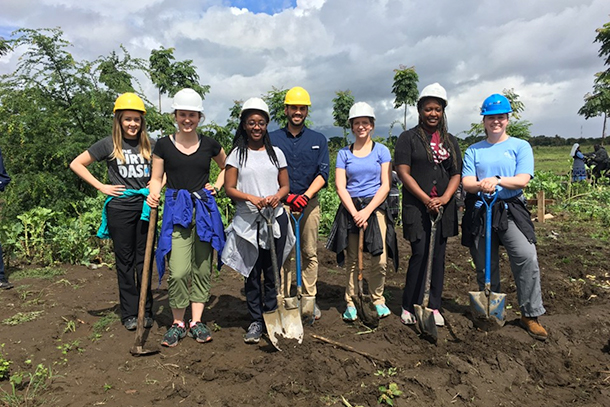
Penn State School of International Affairs student Briana Casey, third from right, in Tanzania alongside her team, including interim HESE Director Esther Obonyo, second from right.
Student travels to Tanzania to bring cold room, crop storage idea to life
05/15/17
UNIVERSITY PARK, Pa. -- Penn State School of International Affairs student Briana Casey is spending her Maymester in Tanzania, where she and a team of students from across the University are putting an idea to the test they’ve worked on for the past semester.
As a part of Penn State’s Humanitarian Engineering and Social Entrepreneurship program, Casey and her interdisciplinary team of colleagues have invented what she calls “an off-grid cold room.” Designed specifically to meet the unique challenges of rural farmers in Tanzania—where only about 7 percent of the rural population has access to electricity—the cold room is envisioned to function as a kind of natural, nonelectric refrigerator that takes advantage of locally sourced materials and evaporative cooling techniques.
“Looking at post-harvest loss in rural Tanzania, we were finding that about 50 percent of farmers’ crops spoil before they can reach the market, so they’re not able to maximize their incomes,” Casey said. “The problem isn’t they’re not producing enough, it’s improper storage, which is what we’re working to address.”
With a cold room that can function in rural East Africa, these farmers will be able to increase the shelf life of their crops, maximize their income, and improve their quality of life.
Casey’s role in this design process, as a student of international development policy, focused on the business side of the project. Some of her major tasks included ensuring the final product will be environmentally sustainable, durable, and culturally appropriate.
“Ensuring our design is culturally appropriate involves communication with the population, making sure we understand the problem from their perspective instead of making assumptions from ours,” Casey said. “This involves researching, listening, utilizing indigenous knowledge, and including the community in the design process—not just designing for them, but designing with them.”
After months of careful research and design, Casey and her team’s finished project won the Georgetown Innovation Marketplace Competition last month, which has helped connect them with development professionals and international organizations with the goal of securing funding for their project.
Now it’s time for them to take the idea off the page and into the real world. For the next month, Casey and her colleagues are on the ground in Tanzania where they’ve partnered with the Nelson Mandela Institute for Science and Technology to begin their pilot program under the leadership of Dr. Esther Obonyo, interim director of HESE. Although Casey said she’s a little nervous now that the time has finally come to see how viable their design truly is, more than anything else, she’s excited.
“I’m looking forward to getting my hands dirty, mixing cement, building walls, and trying to make a difference,” Casey said.
MEDIA CONTACT:
Michael Martin Garrett
mmg5241@psu.edu


